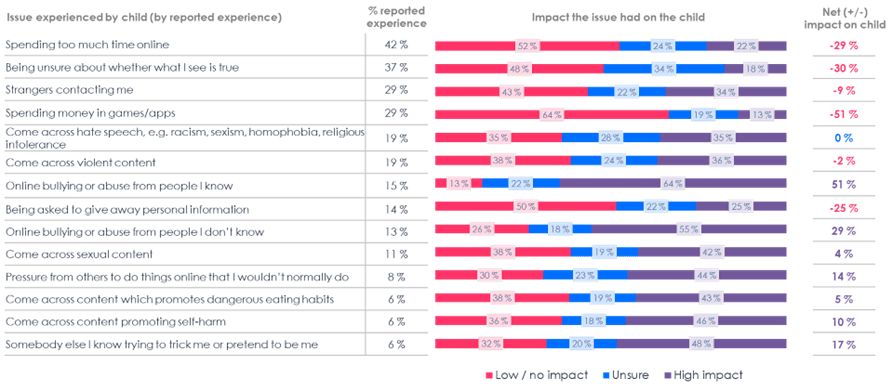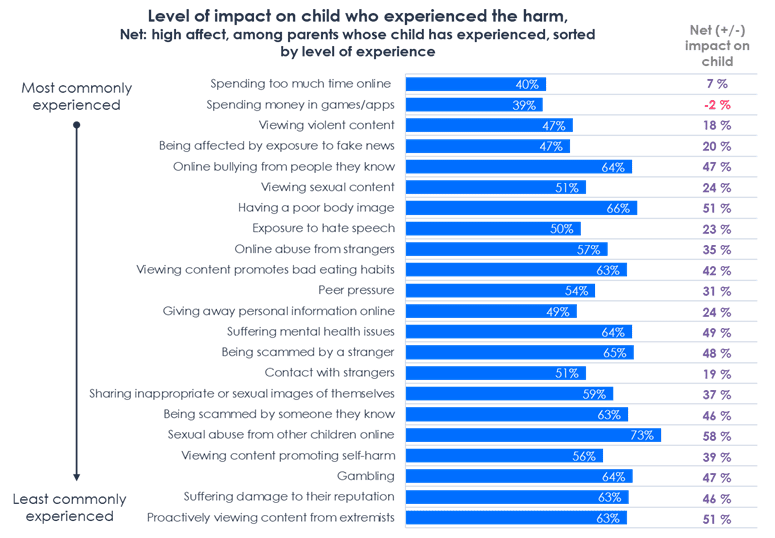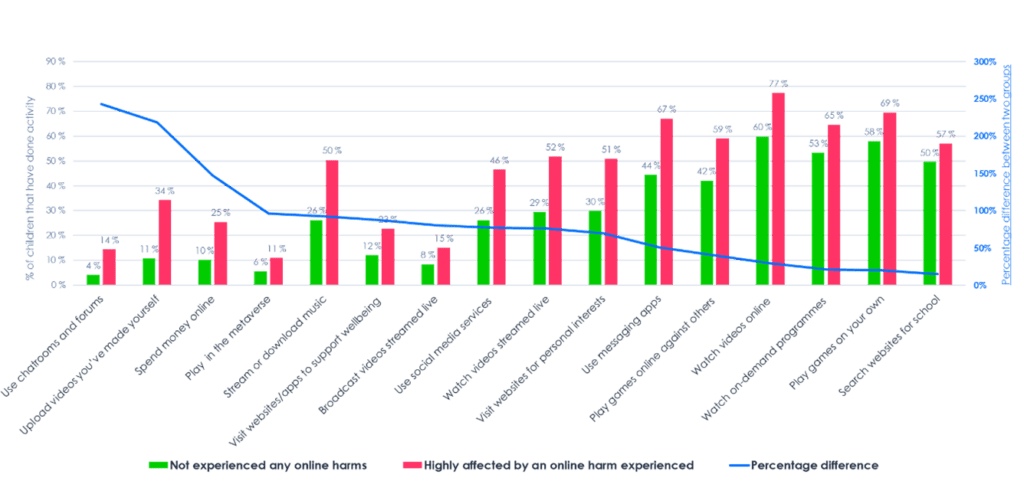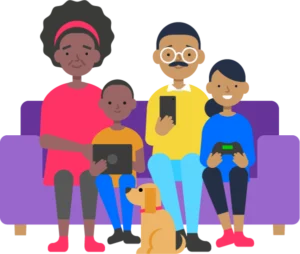This blog series assesses online harms from our tracker survey, analyses who is most impacted and explores why. In this second blog, we explore the impact of the online harm children report experiencing.
Exploring the impact of online harms
In the previous report, we explored the range of online harms experienced by children, according to themselves and their parents.
We discovered that for parents and children, bullying is the biggest top-of-mind concern about being online, and that around 1 in 7 children have experienced bullying. We saw that parents and children often differ in their reporting of online harms particularly around fake news and contact from strangers.
In this report, we will extend the analysis to look beyond the scale of children experiencing specific harms, to the impact of those reported experiences on them.
Summary of findings
- Looking at the impact of online harms on children, from the children’s perspective, only some online harms had a lasting effect on them – mainly those around online bullying. Children stated that they were less impacted by experiences such as spending money on games/apps, fake news and spending too much time online.
- Parents’ reporting on the impact of online harms on their children differed to children’s interpretations. Parents were more likely to say that all online harms have a serious impact on their children.
- Parents are more likely to be concerned by the impact of online harms on their children if the children are vulnerable in some way (e.g. SEND, experience of mental health problems), if they spend a lot of time online and if they were ‘creators’ of online content or using chatrooms/forums.
Parents perceive greater impacts of online harms compared to children’s perception
Children perceive some harms to have a much greater impact on them than others.

The most commonly occurring online harms – spending too much time online, fake news, strangers contacting me, and spending money in games/apps – overall had a smaller impact on children, from their perspective.
Where we see the most considerable impact of online harms was around online bullying from people they knew. Overall, just 15% of children reported experiencing online bullying from people they knew, amongst those, nearly two-thirds of children who experienced online bullying say it caused them serious distress, upset or harm, this is compared to just 13% who say it didn’t affect them much at all (a net impact score of +51%).
We asked parents the same, and the results were quite different. When looking at the net effect of the online harm on children (those that report a high effect minus those reporting a low or no impact), there was some similarity with children – i.e. that the least commonly occurring harms are the most impactful. For example:

- Spending too much time online or on connected devices was the most commonly occurring harm according to parents, with 28% reporting this for their child. Two in five of those parents (40%) said that this resulted in a significant impact, i.e. it caused distress, upset or harm to their child. A third (33%) reported that it had a low or no impact on their child, leaving the net affect score at +7% impact.
- On the other end of the scale, just 6% of parents reported their child suffered ‘sexual abuse or harassment from other children online’. But amongst them, 73% said that it caused them ‘serious distress, upset, or harm’ and just 14% said it had low or no impact, leaving a net impact of 58% – the experience with the highest net
But an important difference was that parents generally thought that all harms had a significant impact on their children. All but one of the online harms measured had a + net impact score meaning that parents generally thought those online harms caused serious distress, harm or upset on their child than a low or no impact. Compare this to children {figure 3} where just half of the online harms measured had the same + net impact score.
Which children were most impacted by online harms
Vulnerable children
Children with offline vulnerabilities (e.g. SEND, experience of mental health problems) were more likely to experience an online harm compared to those without vulnerabilities. 78% of parents with vulnerable children reported their child experienced at least one online harm compared to 56% of parents with non-vulnerable children.
This group were also significantly more likely to be highly impacted by their experience of online harms compared to non-vulnerable children.
Amongst parents who say that their vulnerable child has experienced at least one online harm, more than 3 in 4 (76%) say it left their child in distress or upset. This is compared to 57% of parents with non-vulnerable children who feel a similar impact of the online harm.
Children spending the most time online
Children who spent more time online were more likely to report experiencing an online harm in the first place. Whilst the relationship between time spent online and the experience of an online harm can be contested, and is not necessarily causal, there is a clear pattern between spending more time online and being more likely to experience an online harm.

What children do online
When we asked children what they do online, we saw significant differences between those who had experienced harms with a high negative effect to those who haven’t experienced any online harm.

Children who say they have been highly affected by their experience of an online harm were more than three times more likely to be using chatrooms and forums (+243% difference) and creators (uploading videos they made themselves, +218%) compared to those children who haven’t experienced any online harm. Whether these activities were the root of the online harms experienced is not certain, but the most commonly occurring online harms – fake news, strangers contacting children and hate speech – could occur as result of these activities.
Concluding thoughts
The significant difference in how parents and children perceive the impact of experiencing online harms is an intriguing one. Some parents may overestimate the impact of some of their children’s experiences. But children might not always be grasping the full extent of how they have been impacted.
Bullying is seen by parents and children as one of the most damaging online harms. Most likely this is due to its more common occurrence compared to other online issues, and how the impact is more obvious compared to the impact of seeing fake news online, for example.
We have seen that certain groups of children (or their parents) report being more significantly impacted by online harms than others, including those with offline vulnerabilities. Habits and behaviours are also key drivers to being more impacted, including time spent online and what activities are done online by children. Therefore, support and advice around online harms based on what children do online, as well as their characteristics (including vulnerabilities), is important.






